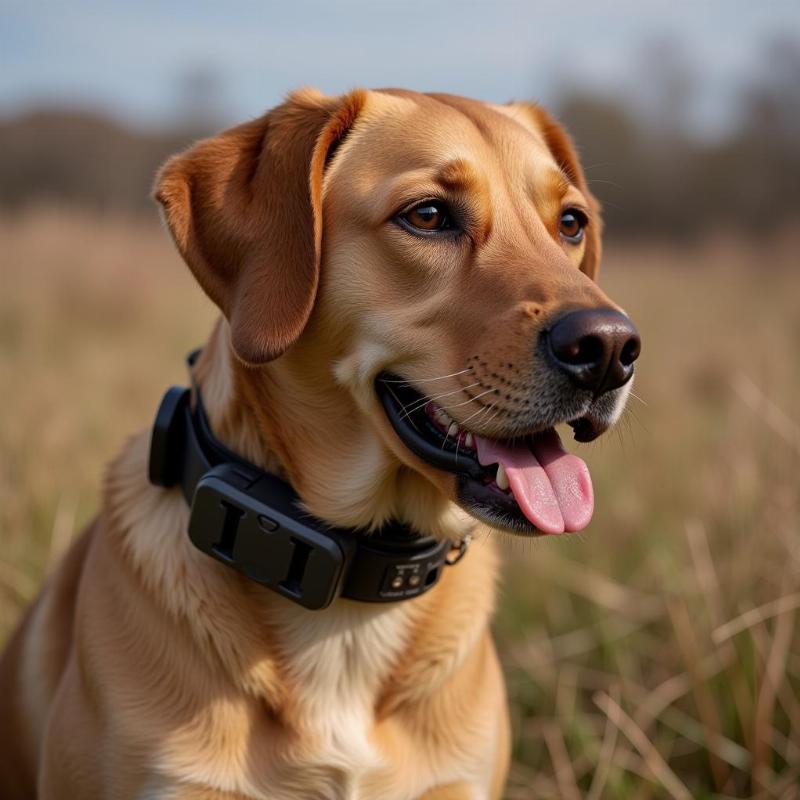Shock collars, also known as e-collars or training collars, are a controversial tool used in dog training, particularly in hunting dog training. While they can be effective in certain situations, their use requires careful consideration and responsible application. Understanding how these collars work, their potential benefits and drawbacks, and how to use them safely and humanely is crucial for any hunter considering this training method.
Understanding Shock Collars for Hunting Dogs
Shock collars deliver a static stimulation to a dog through contact points on the collar. This stimulation can range from a mild tingling sensation to a stronger, more aversive shock. The purpose is to interrupt unwanted behavior and redirect the dog’s focus to the desired action. In a hunting context, this might include staying within a specified range, returning on command, or refraining from chasing unintended game.
Many hunters in the US utilize shock collars to train their dogs for specific tasks related to retrieving, pointing, or flushing out game. The quick and consistent correction provided by an e-collar can be helpful in reinforcing commands and shaping behaviors in a hunting environment. However, it’s vital to understand that misuse can lead to negative behavioral consequences, including fear, anxiety, and aggression.
Benefits and Drawbacks of Using Shock Collars for Hunting
Like any training tool, shock collars have both pros and cons. Understanding these is critical to making an informed decision about whether they are right for you and your dog.
Potential Benefits:
- Reinforcement at a Distance: Shock collars allow hunters to correct unwanted behaviors even when the dog is out of reach, a common scenario during hunts.
- Consistency in Correction: The stimulation delivered is consistent, unlike verbal corrections, which can vary in tone and intensity.
- Breaking Bad Habits: E-collars can be effective in breaking ingrained bad habits that are difficult to address with other training methods.
Potential Drawbacks:
- Risk of Physical and Psychological Harm: If used improperly, shock collars can cause pain, burns, and psychological distress.
- Potential for Misinterpretation: The dog may misinterpret the correction and associate it with the wrong stimulus.
- Dependence on the Collar: Over-reliance on the e-collar can hinder the development of a strong bond and trust between the dog and handler.
Choosing the Right Shock Collar and Using It Responsibly
Selecting the appropriate shock collar and utilizing it correctly are paramount for effective and humane training. The following guidelines can help:
- Consult a Professional Trainer: A certified dog trainer experienced in working with hunting dogs can provide valuable guidance on selecting the appropriate collar and developing a training plan tailored to your dog’s needs.
- Start with the Lowest Setting: Begin with the lowest stimulation level and gradually increase only if necessary. The goal is to find the lowest level that gets the dog’s attention without causing pain.
- Positive Reinforcement: Pair the use of the shock collar with positive reinforcement methods, such as praise and rewards, to create a positive learning experience.
- Timing is Crucial: The timing of the correction is essential for its effectiveness. The stimulation should be delivered immediately after the unwanted behavior occurs.
- dog tracking collar for hunting
 Dog Wearing Shock Collar Hunting
Dog Wearing Shock Collar Hunting
Conclusion
Shock collars can be a useful tool in hunting dog training, but they are not a magic bullet. They should be used responsibly, ethically, and only as part of a comprehensive training program that includes positive reinforcement, clear communication, and a strong bond between the dog and handler. Choosing the right collar, using it correctly, and prioritizing your dog’s well-being are essential for successful and humane training.
FAQ
- Are shock collars cruel? When used responsibly and humanely, shock collars are not inherently cruel. However, misuse can cause pain and psychological distress.
- What age can I start using a shock collar on my hunting dog? Consult with a professional trainer to determine the appropriate age for your specific breed and individual dog.
- Can I use a shock collar for all breeds of hunting dogs? Different breeds have varying temperaments and sensitivities. A professional trainer can advise on the suitability of e-collar training for your dog.
- Are there alternatives to shock collars for hunting dog training? Yes, there are numerous positive reinforcement training methods, such as whistle training and clicker training, that can be very effective.
- How long does it take to train a hunting dog with a shock collar? The training duration varies depending on the dog’s breed, age, temperament, and the complexity of the desired behaviors.
- What are the legal regulations regarding the use of shock collars in the US? Regulations vary by state and locality. Check your local laws regarding the use of electronic training collars.
- How do I choose the right shock collar for my hunting dog? Factors to consider include the dog’s size, breed, temperament, and the type of hunting you will be doing. Consult a professional trainer for guidance.
Related Articles
- remote vibration collar for dogs
- how to keep dogs from jumping on fence
- long distance dog shock collar
- tracking collar for hunting dogs
Beautdogs.us is your premier source for expert advice on dog breeds, care, and lifestyle. We offer comprehensive resources for both novice and experienced dog owners, providing valuable insights into canine health, training, and product recommendations. Our expertise ensures you have the knowledge to provide the best possible care for your beloved companion. For personalized guidance and support, connect with us via email at [email protected] or call us at +1 501-555-7529. Beautdogs.us is dedicated to enhancing the bond between you and your furry friend.